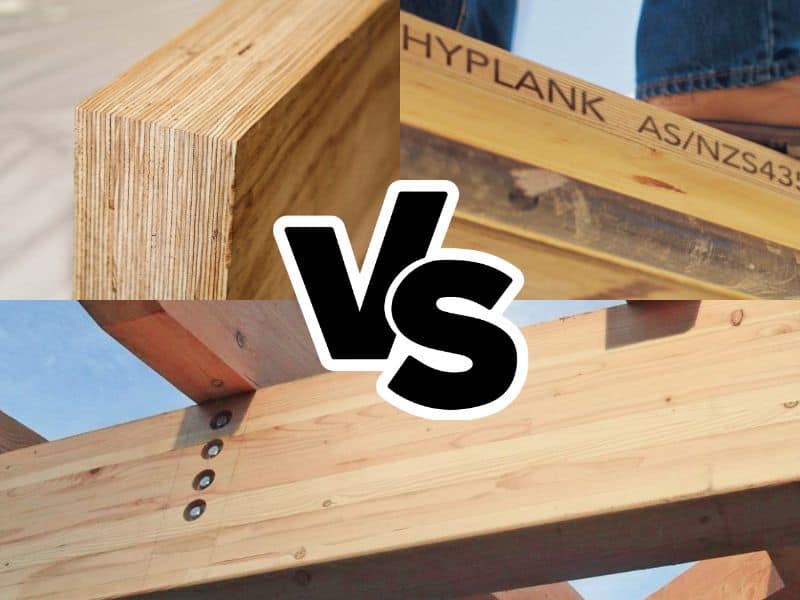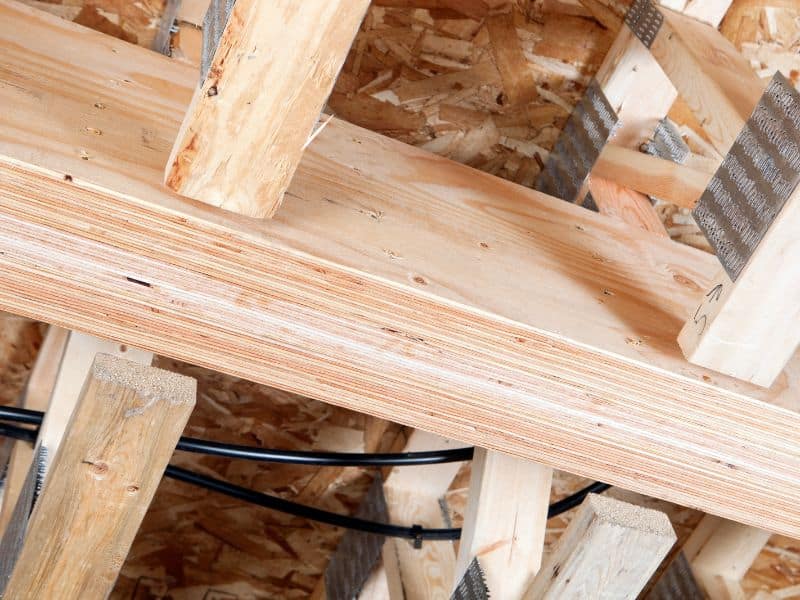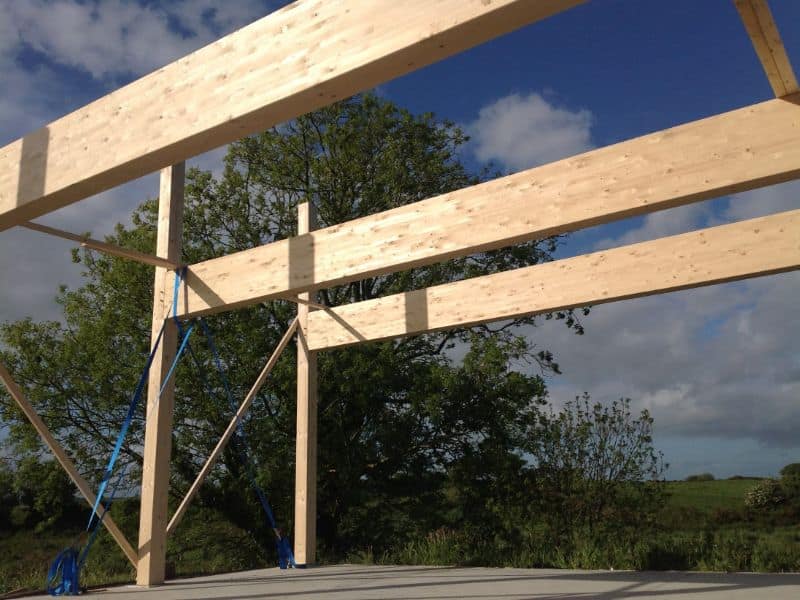Engineered Wood Beams – Which Is The Strongest?

Images courtesy of Kalesnikoff and MaterialDistrict.
Engineered wood beams are becoming popular, especially in this era where sustainable construction is picking up.
Since beams are essential structural components that support the weight of the ceilings, floors, and roofs, they must be made from sturdy materials. Are engineered wood beams strong enough to withstand these heavy loads?
There are many different engineered wood beams on the market today. As a result, finding the right one for your project, especially if you’re new in the construction industry, can be difficult. This guide will help you narrow down your choices.
In the rest of this article, I’ll compare the strengths of the main types of engineered wood beams. Through this head-to-head comparison, you’ll be well-equipped to make an informed decision.
So let’s get started!
Main Engineered Wood Beams

The table below summarizes the main engineered wood beams in terms of some of their commonly available dimensions, strength, and manufacturing process:
| Engineered Wood Beam | Width | Depth | Strength (MPa) | Manufacture |
| Parallel Strand Lumber (PSL) | 3 ½, 5 ¼”, and 7” | 9 1/2” – 24” | 6.82 | Positioning veneers into parallel strands and connecting them with adhesives |
| Laminated Veneer Lumber (LVL) | 3 ½, 5 ¼”, and 7” | 9 1/2” – 24” | 7.96 | Binding thinly sliced veneers parallel to one another by heating them under high pressure |
| Glued Laminated Timber (Glulam) | 3 1/8”, 3 ½”, 5 1/8”, 5 ½”, 6 ¾” | 4-1/2′′ to 7-½” | 54.7 | Joining different types of lumber laminations with specialty adhesive |
| Laminated Strand Lumber (LSL) | 1 ¼”, 1 ½”, 1 ¾” and 3 ½” | 9 ¼”-16” | 8.86 | Binding and heating wood flakes under high pressure |
Table 1: Summary of the different types of engineered wood beams
Which Is Stronger, PSL or LVL?

Although laminated veneer lumber (LVL) has a superior shear strength than parallel strand lumber (PSL), PSL is excellent at resisting bending force.
In construction, shear strength refers to a material’s ability to withstand forces that cause its inner structure to slide against itself.
What does that mean?
It means a building material with high shear strength can bear a heavier load than a weaker material. With that in mind, let’s go back to PSL and LVL comparison.
Torsion tests conducted by ASTM International revealed that LVL has a shear strength of 7.96 MPa while PSL has a shear strength of 6.82 MPa. Consequently, LVL is stronger than PSL in terms of shear strength.
Since the two engineered wood beams vary in shear and bending strength, the ultimate choice comes down to the requirements of your design.
If you want an engineered wood beam that can resist structural loads, LVL is the way to go. On the other hand, if you want an engineered wood beam that can withstand heavy loads with minimal deformation, PSL is your best bet.
Of course, the deeper the beam, the stronger it is. So, choosing the right size of beam is just as important as using the right material. This is a specialist field, so always consult a qualified architect and, if necessary, a structural engineer to ensure the right design for your project.
What Wood Makes the Strongest Beams?

Of all the types of wood commonly used in framed structures, the Douglas fir makes the strongest beams due to its excellent structural strength. This is ironic because we know that Douglas fir is a softwood tree; how can it make the strongest beams?
Well, to understand this, we must examine the structure of the Douglas fir tree.
Although species like oak are stronger than Douglas fir, “Doug fir,” as it is affectionately known, has an incredibly high strength-to-weight ratio and is about 30% lighter than oak. This makes it well-suited to structural uses.
Douglas fir has one of the highest strength-to-weight ratios you’ll ever get for any wood species. This quality means it has an excellent modulus of elasticity, compression, shear, and tension lateral to the grain. These characteristics make Douglas fir stronger and better suited for beam construction than other wood species.
Which Is Stronger Glulam or LVL?
Glulam is stronger than LVL due to its glued lamination design that provides better load-bearing capacity and rigidity. In addition, the lamination of glulam beams creates a stronger beam than LVLs because it can withstand heavier loads without collapsing.

Glulams have been used in engineering for many years and are considered one of the strongest engineered wood products. They are also preferred for building bridges and beams.
Since LVLs are usually made from softwoods, they tend to be weaker than glulams regarding load-bearing.
Let’s now look at the numbers.
According to a study by NIH, a structural glulam beam’s mean strength was 54.7N/mm2. This is a high beam strength compared to other engineered wood beams.
On the other hand, LVL has a mean strength ranging between 32.3 N/mm2 and 97.2 N/mm2, depending on the beam size and quality of the veneers.
With a constant strength of 54.7N/mm2, glulam beams are stronger than LVLs. Even with its variability, the average strength of LVL beams is generally lower than that of glulams.
Are Engineered Beams Stronger?
Engineered beams are designed to be stronger and more stable than their solid wood counterparts. The process of grinding and binding wood fibers with resins and then compressing them increases the density of engineered wood, making the beams stronger.
Furthermore, engineered wood has layers of grains running in different directions. This helps to reduce the natural tendency of wood to shrink and expand with changes in humidity. As a result, these woods have higher stability than solid wood.
High stability plays an essential role in making engineered wood beams stronger.
Can You Drill Through LVL Beams?

Drilling through LVL beams is not advisable because it reduces the beam’s net section at the hole location. This introduces stress concentrations, weakening the beam and reducing its load-bearing capacity.
If you must drill through an LVL beam, its width must be at least 3-1/2 inches. Moreover, you must consult an architect or engineer qualified in wood design. This will help save you from any potential structural failure.
It’s worth mentioning that when drilling a hole through LVL beams, the hole’s diameter should never exceed 38 mm (1.5 in.) or one-tenth of the beam’s depth.
The hole’s location is also essential. It’s recommended that the hole be eight hole diameters from the beam’s end.
You can drill a 25-mm (0.98-inch) diameter hole or smaller at the middle half of the beam if:
- The beam’s depth is at least 184 mm (7.24 inches).
- The beam is subjected to uniform loads only.
- The span-to-depth ratio (l/d) is at least 10.
- The hole doesn’t go through cantilevers.
- The number of holes doesn’t exceed one hole per 1.5 m (5 ft) of beam length.
What Type of Beam Is Strongest?
Power beam is the strongest engineered wood beam. The outer laminations of this beam undergo strict quality control, ensuring uniformity and strength. The inner laminations are made of strong yellow pine MSR lumber, providing an excellent strength-to-weight ratio.
Overall, H-beams are the strongest type made with steel. They have vertical sections called the web and horizontal elements called flanges that, in combination, provide excellent strength.
When compared to other steel beams, H-beams can carry heavier loads over larger spans.
How Much Weight Can an Engineered Beam Hold?

The weight that an engineered beam can support depends on its size and state. For example, an engineered beam can hold 347 pounds per lineal foot.
On the other hand, a double 2×6 engineered beam can hold 694 (2×347) pounds per lineal foot.
Based on this demonstration, how can you get an engineered beam that can hold more weight?
You can increase an engineered beam’s weight-holding capacity by making it deeper and thicker, increasing its cross-sectional area. This increases the bend or “flex” resistance, preventing the beam from sagging.
Alternatively, you can use double beams instead of single ones for heavier loads.
Is a Glulam Beam Stronger Than a Wood Beam?
Due to its engineering design, a glulam beam is stronger than a wooden beam. Glulam is made by laminating at least three pieces of kiln-tested, finger-jointed, and stress-tested lumber and binding them to form a continuous lamination.
This lamination design increases the strength of the glulam.
How Far Can a Glulam Beam Span Without Support?

According to the glulam span size rule of thumb, a glulam beam can span between 16 and 20 feet (4.88 and 6.1 meters) without support. However, it is possible for an appropriately designed glulam beam to span more than 100 feet.
The formula for calculating the exact glulam beam span length, based on the glulam span size rule, is:
Glulam beam span = (Beam’s depth in inches ✖ 20)/12 = Span length in feet.
For instance, how far can you span a 5″ × 12″ glulam beam?
Glulam beam span = (12×20)/12) = 20 feet (6.1 meters).
This is just a rule of thumb and will give you a rough indication of possible span distance. However, the distance will be affected by overall cross-sectional area and other factors, so it is essential that you consult a qualified professional to get an accurate estimate of how far your glulam beam can span without support.
Does Engineered Wood Break Easily?
Low-density engineered wood, like particleboard, is highly susceptible to breakages. This is because these types of engineered woods are made using thin wood veneers and recycled wood fibers, making them weak.
High-density engineered woods like MDF or Medium-Density Fiberboard have high strength and don’t break easily. They are made of reconstituted timber particles glued together under pressure to form a strong material for furniture and other items.
Are LVL Beams Stronger Than Lumber?
LVL beams are up to 2.5 times stronger than conventional lumber. LVL beams derive their high strength from quality bonding that displaces naturally-occurring knots that causes stress points in the lumber.
LVL beams are also more consistent than conventional lumbers, making them less likely to fail.
Due to their lightweight nature, LVL beams have a high strength-to-weight ratio, making them ideal for applications where support is needed at longer distances.
Do LVL Beams Sag?

LVL beams sag in areas with overhead point loads that are too high. There is also a chance that the beam sags due to poor installation or placement on uneven ground.
To avoid LVL beams from sagging, make sure that you adhere to the manufacturer’s load specifications and recommend installation methods. Additionally, use quality supports and fasteners for your beams.
How Strong Are LVL Beams?
LVL beams have a strength capacity ranging between 32.3 MPa to 97.2 MPa. The strength of an LVL beam depends on its size and the quality of the veneers used.
Deeper and wider LVL beams with high-quality veneers have higher strength capacities than their shallower and narrower counterparts.
How Far Can You Span a 2×10 LVL Beam?
You must always get professional advice from a qualified architect or engineer because the exact span that a beam can manage will depend on the load being supported, the type of wood used, and other factors.
Code requirements also vary from place to place, so you must comply with those, or you could be slapped with fines and expensive rework.
The span length of an LVL beam depends mainly on its size, the type of load it’s carrying, and the LVL span table provided by the manufacturer. In an example provided by Home Depot, one of their 2×10 joists could span up to 21 feet.
Final Thoughts
The above head-to-head comparison between glulam, LVL, and PSL engineered wood beams shows that glulam is the strongest.
With a mean strength of 54.7 MPa, glulam beams can withstand high structural loads and support ceilings, roofing, walls, and floors. Therefore, it’s your go-to option if you’re looking for an engineered wood beam with excellent strength.
However, as with any construction project, it’s essential to consult an engineer or an architect before you begin the work.
Having read this far, you might be interested in other forms of sustainable construction. If so, here are the top 10 sustainable methods to build with.








I need to replace a vertical 6” x 6” x 8’ beetle infested solid wood post ( ponderosa pine ). It supports one side of a 6”x6”x12’ horizontal ceiling beam. Post and beam are part of interior room construction.
Could I use a Glulam 6×6 to replace the vertical post and be confident it would carry that load ?
Would Glulam be resistant without further treatment to spruce beetle infestation?
Except for the vertical post, no further evidence of beetles is to seen….
Than you for your time
Tim Crosby
That glulam post would be doing some serious supporting work, so I’d check with the manufacturers rather than some bloke off the internet. 🙂